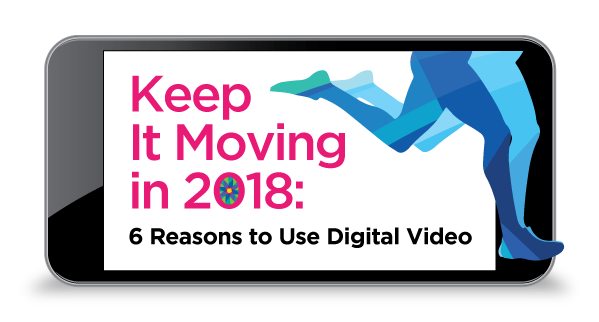I recently read an article from eMarketer that confirmed what I’ve already seen in the media landscape: digital video is here, and it’s scaling. While we Midwesterners love our traditional media marketing–there is nothing like a vibrant billboard to break up the monotony of I-80, or any interstate, really—it’s hard to deny the impact moving ads have on the digital landscape.
Here’s a quick summary of what we can look forward to in 2018.
We’re only getting started with connected television advertising.
According to eMarketer, over 181 million people in America will plug into their smart TVs at least monthly. That means 55% of the entire population will connect to the internet for their entertainment. And while this connected television experience is predicted to grow to 194.4 million users by 2021, connected advertising is only just testing the market. (If you watched college football on Hulu, you’ve experienced this; instead of a commercial, you just get a logo screen saying there’s a break in programming–which drives media marketers like us at MediaSpark bonkers).
Once those business and logistical hurdles are tackled, though, expect to see more local and national companies swooping in to grab any available space to stay in front of their target audience while their connected TV’s are turned on, and they are readily tuned in.
Expect TV-style shows to start showing up in your social newsfeeds.
While video has been the focus of the social media giants for years, leaders like Facebook, Twitter, Instagram, and Snapchat are looking to hold your attention a little longer with mid-length ad rolls. Those short, share-worthy clips will start showing a more developed narrative arc, a deeper backstory, and progressive content, which means you could feel as connected to brands as you do your friends–which is precisely the point.
“Peak TV” will plateau.
The unprecedented growth of the digital scripted series has doubled the number of available shows to watch, and since we can now watch when and where and how we want to, “peak” advertising slots are starting to flatten out. After all, there are only so many hours in a day, even if we didn’t have to work and sleep. Expect the number of new shows to drop and the quality to improve; with so many metrics available to account for viewership, popularity, and cost-per-episode, it won’t take long for networks and leading streaming providers to figure out which shows are worth keeping.
Over The Top (OTT) Services Will Keep Going Over The Top.
Over The Top services, the ones you use in addition to the network service you purchase from your cable or internet provider, are here to stay. In 2017, Hulu with Live TV and YouTube TV joined Sling TV, DirecTV Now and PlayStation Vue as the providers of digital and network TV bundles. Marketed as lower-cost alternatives, these products are geared toward folks who “cut the cord,” but don’t want to give up their favorite sports teams, newscasts, and television shows and more than they want a ton of apps for different content. Right now, they are only slowed down by the number of supported devices, channel selection, and geographic location, but don’t expect that to stay that way.
Subscription Video Subscriber Growth Will Tap Out.
Now that subscription video-on-demand (SVOD) is a household term, it will start to trail off. Netflix, which has led the way in numbers of streaming subscribers and revenues, will likely find it more and more difficult to sustain that growth with so many competitors hot on their heels. With more coveted shows showing up on Amazon, Hulu, HBO, and even ABC, ESPN, and smaller SVODs, we’ll start to see a more distributed offering across more channels.
Video is still a hard machine to keep running.
Now that I’ve touted how video will keep expanding into our lives throughout the coming year, it’s time to talk real numbers. Video is awesome, but video production can be expensive. While the payoffs for video are typically greater than with text and static images, it’s hard for many large and small companies to justify the infrastructure investment. Many companies make the jump by outsourcing video production and placement, thereby minimizing the investment, risk, and commitment while maximizing the payoffs.
By doing both text and video, marketing teams can create “moving content that moves”–content that emotionally cultivates audiences, relationships, and connections–while incorporating it into the mix of text-based vehicles to maximize the ad revenues. With careful planning, thoughtful strategy, and smart messaging, these companies can make the leap to video without losing sight of the bottom line.
Questions? Email me >> [email protected]





